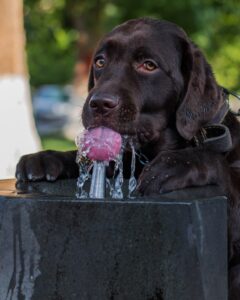July Is Pet Hydration Awareness Month!
It’s the middle of summer. The sun and humidity are high, the sweat is pouring, and those wavy mirage lines are floating above road surfaces. We’re bombarded by heat warnings reminding us that if we don’t drink enough water we can become dehydrated, develop heat stroke, or even end up in the hospital. And the same goes for our pets.
lines are floating above road surfaces. We’re bombarded by heat warnings reminding us that if we don’t drink enough water we can become dehydrated, develop heat stroke, or even end up in the hospital. And the same goes for our pets.
How can you tell if your dog or cat is dehydrated? How can you make sure your pet gets enough water every day? What are the signs of a pet drinking too much water?
The general rule for water consumption for dogs and cats is one ounce per pound of body weight per day. If this need isn’t met — or too much is lost due to the heat — dehydration occurs.
Some signs of dehydration in dogs and cats include:
- Loss of appetite
- Lethargy
- Sunken, dry-looking eyes
- Panting
- Dry, sticky gums
- Dry nose
- Vomiting
- Skin stays up when you gently pinch and pull up on it (tenting)
There are several ways to make sure your dog or cat is getting enough water every day.
Feeding them canned food, which is about 70% water, can make a big difference.
The water bowl is also an important factor when it comes to water consumption. Stainless steel bowls are best, as they delay the growth of bacteria, and they should be cleaned daily to make sure there is no build-up of bacteria.

Make sure the bowl isn’t near your cat’s litterbox and that it’s out of direct sunlight. If your cat likes to drink out of the faucet or has trouble drinking out of a traditional water bowl, consider a water fountain.
For dogs that spend time outside, a sprinkler system may be beneficial (just let the hose run for a bit first, to flush out the hot water that sits in the tubing).
Don’t offer your dog ice cubes or ice water, especially after playing outside. They can shock the stomach and cause a life-threatening condition called bloat. Instead, you can offer them chilled, pet-safe fruits and veggies for a moisture-filled treat.
Some pets can’t get enough of the pool, garden hose, or river water — which can provide lots of entertainment, but also some serious health problems.
Water intoxication can cause a deficiency of sodium, which can lead to neurological issues like seizures or incoordination, or gastrointestinal problems such as bloating, vomiting, excessive drooling, or even troubled breathing.
When should you seek veterinary care for dehydration or heat stroke? If you notice any of the signs listed above, get your pet into the shade or an air-conditioned area. You can apply lukewarm or cool water to their paw pads. Soaking a wet towel in lukewarm or cool water — not icy! — and draping it over the body can also help bring down their temperature.
If your pet isn’t back to its usual self after 30 minutes, call your vet. If your pet is dizzy, disoriented, struggling to breathe, vomiting, or having diarrhea with blood, call your vet or go to a veterinarian ER!
Just remember — if it’s too hot for you, it’s too hot for them! Be safe, be well, and stay hydrated this summer.

